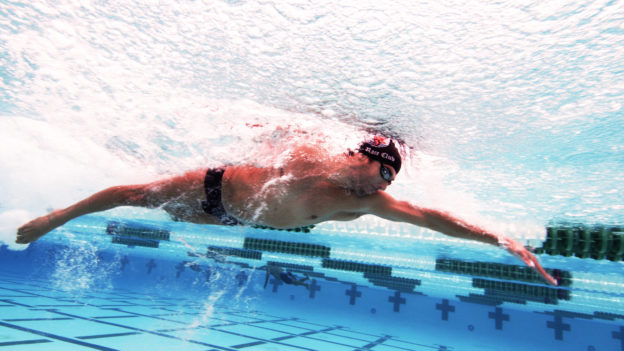The Correct Pulling Motion for Sprint Freestyle
Although much attention has been directed to using a high elbow pulling motion in freestyle, at The Race Club, we do not believe that is the best pulling technique for the 50-meter sprint event. In the 50-meter freestyle sprint, the elite athletes drop their pulling elbows deeper into the water rather than pulling with an extremely high elbow. Like Anthony Ervin, Roland Schoeman, and Brad Tandy, pull with nearly a straight arm beneath them. Here is why.
Most of the propulsion from the pulling arm is coming from the hand, not the forearm. To generate the most propulsion from the pulling hand, there are two important considerations. One is mechanical. The other is biomechanical.
A pulling arm is considered to be a class III lever. That means that the pulling force (muscles attached to the arm) and the load force on the hand (as the hand moves backward) are located on the same side of the fulcrum of the lever (the swimmer’s shoulder). With this type of lever, with the load force so far away from the pulling force, there is no mechanical advantage. By bending the elbow more, and by bringing the hand closer to the fulcrum, a slight improvement is gained, but there is still no significant mechanical advantage.
However, there is a big difference between the deeper pull and the high elbow pull when it comes to biomechanical considerations for propulsion. A deeper pull will engage more of the larger latissimus dorsi and pectoralis muscles, enabling the swimmer to press the hand back through the water with more force. The high elbow pulling motion relies more on the weaker muscles of the scapula for propulsion. So that begs the question, why doesn’t everyone pull with a deeper elbow?
The reason has to do with drag forces. While the deeper pulling motion increases a swimmer’s propulsion, it also increases frontal drag. That occurs during the earliest phases of the pulling motion, mostly from the upper arm. A sprinter can sustain the higher drag forces for a short distance but not for long. For any event longer than 50 meters, the elbows need to start coming up, so the brakes don’t go on each time you pull.
We recently tested Olympian freestyle sprinter, Brad Tandy, with his normal, deep pulling motion and a higher elbow pull. The test was performed over the exact same distance of 10 meters after the breakout, at full speed, and using Velocity Meter Technology. With the deeper pulling motion, Brad’s average speed over 10 meters was 1.917 m/sec. With the higher elbow pull, his average speed dropped to 1.891 m/sec.
The difference in speed of .026 m/sec between the two pulling techniques over 21 seconds represents about .55 meters difference in position – enough to win or lose a race.
The deeper pulling motion works better for the short freestyle sprints. This week’s video release describes a freestyle drill with Brad and elite sprinter, Payton Sorenson, that will help you find the right spot for your elbow position on the sprint freestyle underwater pull. Enjoy!
Yours in Swimming,
Gary Sr.

